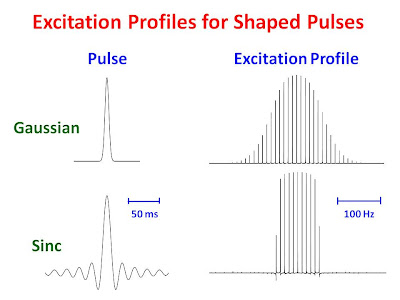Excitation Profiles for Shaped Pulses
Shaped pulses are very commonly used for
selective excitation and
nonselective inversion in a large number of NMR pulse sequences. The frequency domain excitation profile of a radio frequency pulse is the Fourier transform of the time dependent pulse shape and determines the width, uniformity and phase of the frequency spectrum excited. Since time and frequency are reciprocals of one another, short rf pulses have very wide excitation profiles and long rf pulses have very narrow selective excitation profiles.
In a previous BLOG post the excitation profiles of rectangular pulses of varying duration were determined experimentally. The Fourier transform of a rectangular pulse is a
sinc function which is observed to be the experimentally determined excitation profile. Short high power rectangular pulses are very desirable for uniform excitation over wide frequency ranges as the entire NMR spectrum of interest usually occupies only a very small central portion of the central lobe of the sinc shaped excitation profile which, to a first approximation, is flat over the observed spectral width. Rectangular pulses are often not desirable when narrow excitation profiles are required as the excitation is not uniform over the desired region and the ripples of the sinc excitation profile cause nodes of excitation and negative peaks.
The Fourier transform of a sinc function is a box function, so if a long low power sinc shaped rf pulse is used one obtains a narrow flat box shaped excitation profile. This is indeed the case as can be seen in the bottom trace of the figure below. The trace is composed of a series of 1H NMR spectra of H2O/D2O where a truncated, 200 msec, 10 cycle sinc shaped monochromatic rf pulse was applied with varying rf frequency offsets. One can see that the excitation profile is, to a good approximation, a narrow flat box function. The deviation from a flat box function is the result of the truncation of the sinc pulse. It should be noted that the phase of the resonances is not constant across the excitation profile. Sinc pulses are not frequently used for selective excitation because of the phase problem and the fact that very long, minimally truncated pulses must be used. A frequently used alternative to the sinc pulse for selective excitation is the
Gaussian shaped pulse. The Fourier transform of a Gaussian is a Gaussian and one therefore will obtain a narrow Gaussian shaped excitation profile when a long low power Gaussian shaped pulse is used. This is shown in the top trace of the figure below. This trace is similar to the bottom trace except a 20 msec Gaussian shaped pulse (with truncation at 1 % of the total height) was used rather than a 200 msec sinc pulse. Although the excitation is not flat, the phase is constant across the excitation profile and the total duration of the pulse is 10 times shorter than the sinc pulse.




Source:
University of Ottawa NMR Facility Blog



